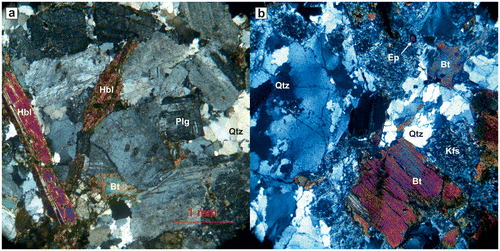Abstract
The Karacabey Pluton is a large magmatic body in the northwestern Turkey overthrust by the probable Triassic metamorphic rocks of the Lower Karakaya Complex. Both the metamorphic rocks and the Karacabey Pluton are unconformably overlain by a Lower Jurassic and younger sedimentary sequence. The Karacabey Pluton was regarded as a Carboniferous intrusion based on the previous K-Ar biotite geochronological data. Here, we provide new geological, geochemical and geochronological data from the Karacabey Pluton. Zircon U-Pb results from two samples yielded ages of 393.8 +/−2.7 to 395.9 +/−4.09 Ma, suggesting that the granitoids intruded in the crust throughout the Early to Middle Devonian. The Karacabey Pluton consists mainly of biotite and locally hornblende bearing granitoid with lesser amounts of S-type leucocratic granodiorite, all of which are cut by pegmatitic bodies. It belongs to the high-K calc-alkaline series with distinct Nb and Ta anomalies in multi-element spider diagram. Sr and Nd isotopes’ initial values are 0.709–0.712 and 0.511–0.512, respectively. εNd(i) values range between −7.8 and −9.4. The isotopic characteristics of the rocks indicate lower crustal sources of both metapelitic and metaigneous origin. Geochemical features of the rocks suggest that they developed in an arc-related environment, along with the other Devonian granitoids described from the Biga Peninsula in northwest Turkey. The granitoid shows a low-temperature alteration/metamorphism marked by recrystallization of quartz, sericitization of the feldspar and formation of late chlorite, epidote and muscovite. Possibly because of these, the Ar–Ar biotite ages are scattered with a possible concentration at around Permo–Carboniferous boundary. Zircon (U-Th)/He geochronology suggests that after the granitoid was reburied during Early Jurassic to Early Cretaceous sedimentation, there was renewed uplift and erosion during the Late Cretaceous (Turonian), which is possibly related to the closure of the Intra-Pontide Ocean in the north.
1. Introduction
The Sakarya Zone of the Pontides is an E-W trending belt bounded by Istanbul Zone in the north and by the Izmir-Ankara Suture in the south (Figures and ). It consists of a complex basement overlain by Jurassic and younger sedimentary sequence. The basement rocks of the Sakarya Zone can be divided into two separate parts: 1. Paleozoic plutonic and metamorphic rocks possibly related to the Variscan orogeny and 2. Triassic accretionary complexes with blueschists and eclogites, called as the Karakaya Complex (Okay & Göncüoğlu, Citation2004; Okay & Tüysüz, Citation1999; Okay, Satır & Siebel, Citation2006).
Figure 1. Distribution of the Paleo-Tethyan accretionary complex and Variscan basements in the Pontides, N Turkey (modified from Okay & Göncüoğlu, Citation2004). Distribution of the Variscan magmatism is adopted from; 1- Okay et al., 1996 and Okay et al. (Citation2006), 2- Aysal et al. (Citation2012), 3- this study, 4- personal unpublished data, 5- Ustaömer et al. (Citation2012), Nzegge et al. (Citation2006), 6- Topuz et al. (Citation2010); Dokuz (Citation2011), 7- Ustaömer et al. (Citation2012b).
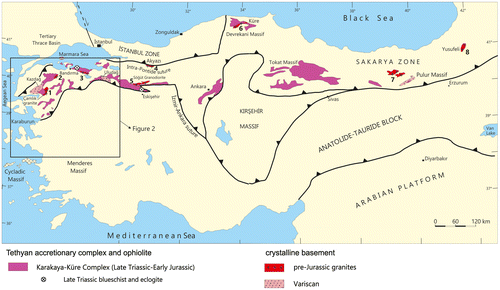
Figure 2. The geological map of the Biga Peninsula (slightly modified from Altunkaynak et al. (Citation2012) and the references therein).
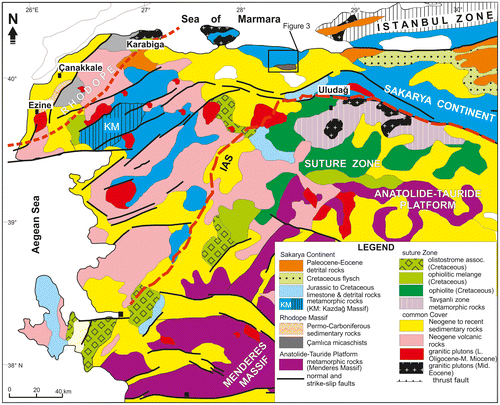
Most of the plutonic rocks in the basement of the Sakarya Zone are of Carboniferous age (350–320 Ma, Figure ). These can traced from the Kazdağ Massif in the Biga peninsula (308–329 Ma, Okay et al., Citation1996, Citation2006), through west of Ankara (~290 Ma, Okay et al., Citation2006, 319–327 Ma; Ustaömer, Ustaömer & Robertson, Citation2012) and Central Pontides (275–295 Ma, Nzegge, Citation2008; Nzegge, Satır, Siebel & Taubald, Citation2006) to the Eastern Pontides (308–325 Ma, Dokuz, Citation2011; Kaygusuz, Arslan, Siebel, Sipahi & İlbeyli, Citation2012; Topuz et al., Citation2010; Ustaömer, Robertson, Ustaömer, Gerdes & Peytcheva, Citation2012). These granitoids are often associated with high-temperature metamorphic rocks. The best studied of the Carboniferous metamorphic complexes are those of the Pulur region, characterized by partial melting and sillimanite–cordierite–garnet mineral paragenesis, which have yielded 331–327 Ma monazite ages (Topuz, Altherr, Satır, Schwarz & Sadıklar, Citation2001). In contrast to the widespread Carboniferous granitoids, Devonian granitoids are rare and are apparently restricted to the western part of the Sakarya Zone. They were first reported from the southern part of the Biga Peninsula (Figure ). This Çamlık Granitoid gave zircon Pb-Pb ages of 399–397 Ma (Okay et al., Citation1996, Citation2006). Aysal et al. (Citation2012) showed that some of the other granitoids in the northern part of the Biga Peninsula are also of Devonian age (401–389 Ma) and provided geochemical data showing that they are related to subduction or delamination and/or slab-breakoff models. Here, we show that the Devonian granitoids extend farther east toward Bursa. We provide new geological, isotopic and geochemical data from the Devonian Karacabey Pluton from west of Bursa (Figures and ), which was previously considered of Permian age on the basis of K-Ar biotite data (Delaloye & Bingöl, Citation2000). We also chart its subsequent thermal history through new Ar–Ar biotite and zircon U-Th/He ages.
2. Geological setting
The region between Karacabey and the Sea of Marmara is constituted of a thick series of metamorphic rocks of the Lower Karakaya Complex. The metamorphic rocks are dominated by metabasites (more than 80% of the sequence) with lesser amounts of phyllite and marble and a few lenses of serpentinite. The metamorphism is in greenschist facies with actinolite/hornblende + albite + epidote + chlorite assemblage in the metabasites. The metabasites include at least one tectonic lens of Triassic eclogite dated at 205 ± 3 Ma (Okay & Monié, Citation1997). In the south, the metamorphic rocks lie tectonically above a granitoid, the Karacabey Pluton, which makes a 6 km long and 2.5 km wide body. The Karacabey Pluton is unconformably overlain by Lower Jurassic sandstone and conglomerates, which pass up into a thick sequence of Middle-Upper Jurassic to Lower Cretaceous marine limestones (Figure , Altıner, Citation1991; Ergül et al., Citation1986). The limestones are conformably overlain by a thin horizon of red mudstones, which includes clasts derived from underlying carbonates, which passes up into a thick sequence of turbidites. The sedimentary section ends with thin-bedded cherts (Figure ).
Figure 3. Geology of the Karacabey region (modified from Ergül et al., Citation1986). Note the uneven trace of the contact between Permo-Triassic metamorphic rocks and the Karacabey Pluton, which is interpreted by us as a thrust.
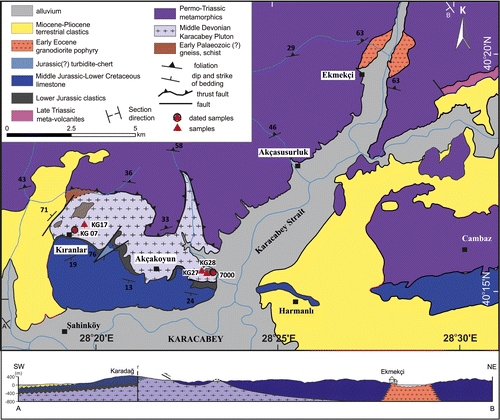
North of the main body of the Karacabey Pluton, a small stock of granodiorite porphyry intrudes the metamorphic rocks of the Lower Karakaya Complex. This shallow-level intrusion, which was considered as part of the Karacabey Pluton in previous studies (Ergül et al., Citation1986), is of Early Eocene age (personal unpublished data).
3. Lithology and petrography of the Karacabey Pluton
The country rocks, in which the Karacabey Pluton intruded, are only observed north of the village of Kıranlar (Figure ). They consist of intercalated gneisses and schists; the gneisses are light gray, banded and consist mainly of 0.5–1.0 cm long porphyroclasts of feldspar and quartz. The schists are gray, foliated and fine grained (<1 mm). The mineral assemblage in the gneisses and schists is quartz, K-feldspar, plagioclase, biotite, chlorite and minor muscovite. The metamorphic rocks are cut by pegmatitic veins that most probably related to the magmatics of the Karacabey Pluton.
The Karacabey Pluton includes a range of different rock types. The common rock type is biotite-rich granodiorite consisting of quartz (~23%), plagioclase (~42%), K-feldspar (~23%), biotite (3–10%), ±hornblende (<5%) and minor ± sphene, apatite, zircon and opaque minerals. Secondary minerals are epidote, chlorite and muscovite. Biotites are largely replaced by chlorite, and secondary muscovite has developed along the veins or/and cracks. Plagioclase is replaced by sericite. Hornblende and sphene are only observed in the western part of the complex (samples KG 07 and 17) (Figure ). Granodiorites are mostly equigranular and medium grained (up to 5 mm), but sometimes are fine grained (~1 mm) along 2–5 m thick zones. The granitoid is massive and does not show any foliation.
Other rock types in the Karacabey Pluton are muscovite- and garnet-bearing leucocratic granite and pegmatitic veins. Muscovite- and garnet-bearing leucocratic granite is only exposed north of Kıranlar Village (Figure ). It contains quartz, K-feldspar, plagioclase, muscovite, garnet and minor opaque minerals. Pegmatitic veins cut both the biotite-rich granodiorite and the leucocratic granite indicating that they are the last phase of the magmatism in the region. The muscovite- and garnet-bearing leucocratic granite is not analyzed in this study because of its small exposure and scarce outcrops in the field. Contact relationship with other rock types is not also obvious.
A low-grade alteration and metamorphism in the Karacabey Pluton are shown by recrystallized quartz, strained biotite flakes and secondary chlorite, epidote and muscovite (Figure ). However, no development of cleavage and lineation is observed in the Karacabey Pluton. A gneissic texture is observed in a few places, but it is not clear whether it is metamorphic or formed during the intrusion. A late cataclastic fabric is common in the Karacabey Pluton, which is cut by late veins filled by quartz and muscovite.
3. Analytical techniques
3.1. Whole-rock analyses
The whole-rock powders were split from 1–5 kg of crushed rocks. Whole-rock analyses were performed at Acme Analytical Laboratories Ltd. in Vancouver, Canada. Two hundred milligrams of rock powder was mixed with 1.5 g of LiBO2 flux in a graphite crucible. Subsequently, the crucible was placed in an oven and heated to 1050 °C for 15 min. The molten samples were dissolved in 5% HNO3 (ACS-grade nitric acid diluted in demineralized water). International reference samples and reagent blanks were added to the sample sequence. For analyses of major elements and the trace elements Ba, Nb, Ni, Sr, Sc, Y and Zr, sample solutions were aspirated into an ICP emission spectrograph (Jarrel Ash AtomComb 975). For the determination of other trace elements including rare earth elements, the solutions were aspirated into an ICP mass spectrometer (PerkinElmer Elan 6000). Accuracy for major elements is better than 2% and for trace elements better than 10% relative.
3.2. Sr-Nd isotope analyses
Isotope ratio measurements were performed on the Finnigan MAT 262 TIMS located at the Isotope Geochemistry Group of the University of Tübingen (Germany). Sample powders were weighted into Teflon beakers and mixed with adequate amounts of tracer solutions enriched in 87Rb-84Sr and 149Sm-150Nd, respectively. Digestion was achieved via HF (48%) – HNO3 (65%) acid attack by placing the closed beakers on a hot plate at 140 °C. Digested samples were dried and transformed to chlorides in 6 N HCl. The samples were then redissolved in 2.5 N HCl for chromatographic separation. Rb, Sr and light rare earth elements were purified by conventional ion exchange chromatography using quartz glass columns filled with BioRad AG 50 W-X12 (200–400 mesh). Subsequent separation of Sm and Nd was achieved using a reverse ion chromatographic procedure using quartz glass columns filled with HDEHP resin (Richard, Shimizu & Allegre, Citation1976). Sr separates were loaded with a Ta-activator on W single filaments and isotope ratio measurements were performed in dynamic mode. Rb was loaded on Re double filaments. Analytical mass fractionation was corrected using a 88Sr/86Sr ratio of 8.375209 and exponential law. Long-term reproducibility for NBS SRM 987 (n = 30) is 0.710248 ± 11 for 87Sr/86Sr-ratio. Total procedural blanks (chemistry and loading) were <450 pg for Sr and <15 pg for Rb. Sm and Nd were loaded as phosphate on Re double filaments and measured in static multiple collector mode. Analytical mass fractionation was corrected with 146Nd/144Nd of 0.7219 using exponential law. Repeated measurements of the La Jolla Nd standard (n = 12) gave a 143Nd/144Nd ratio of 0.511838 ± 13. Procedural blanks were <90 pg for Nd and <20 pg for Sm.
3.3. Zircon U-Pb LA-ICP-MS technique
Zircons were extracted from rock samples by standard mineral separation techniques, crushing, sieving, Frantz isodynamic magnetic separator, heavy liquids, and were finally handpicked under a binocular microscope. Then, a fraction with grain sizes 63–200 μm was classified according to crystal properties (i.e. euhedral morphology, lack of overgrowth and visible inclusions). The grains were mounted in epoxy, polished and imaged using cathodoluminescence (CL) on a Zeiss Evo 50 EP scanning electron microscope at the Hacettepe University in Ankara.
Laser ablation inductively coupled plasma mass spectrometry (LA-ICP-MS) was conducted at the University of California, Santa Barbara following Kylander-Clark, Hacker and Cottle (Citation2013). The laser spot size, repetition rate and ablation rate were 30 μm, 4 Hz and ~0.1 μm/pulse, respectively. U-Th-Pb isotopic ratios and their uncertainties were calculated using Iolite (Paton et al., Citation2010), which corrects for downhole fractionation and machine drift using a primary reference material. The primary reference material was 91500 zircon; SL-1, GJ-1 and Plešovice zircon were used as a secondary reference materials and yielded ages within 2% of their accepted values. As such, we conservatively included 2% error in the final age calculation of our unknowns.
Final age calculations performed using computer program Isoplot 3.0 (Ludwig, Citation2003). TuffZirc way is defined for the age calculations. TuffZirc method is a statistical way to eliminate mixed ages that mainly caused by inherited cores or metamorphic zircon overgrowths (for details see program manual Isoplot 3.0, Ludwig, Citation2003).
3.4. Biotite Ar–Ar dating method
40Ar/39Ar dating was performed at the Open University at Milton Keynes, UK. Biotite separate was obtained by conventional techniques including crushing, sieving, magnetic and heavy liquid separation, hand picking and ultrasonic cleaning. All samples were irradiated at McMaster University in Canada. Irradiation flux was monitored using the GA1550 biotite standard with an age of 98.79 ± 0.54 Ma (Renne et al., Citation1998). Sample J values were calculated by linear interpolation between two bracketing standards; a standard was included between every 8–10 samples in the irradiation tube. J values are included in the full dataset presented in the Auxiliary material. Results were corrected for blanks measured either side of every two mineral analysis (average blanks are included in the Auxiliary material), 37Ar decay and neutron-induced interference reactions. The correction factors used as follows: (39Ar/37Ar) Ca = 0.00065, (36Ar/37Ar)Ca = 0.000265 and (40Ar/39Ar)K = 0.0085 were based on analyses of Ca and K salts. Analyses were also corrected for mass spectrometer discrimination (283).
Samples were loaded into an ultra-high vacuum laser port and placed under a heat lamp for 8 h to reduce atmospheric blank levels. Total fusion of single grains was achieved using a continuous wave SPI infrared (IR) laser (1050–1250 nm) coupled to an automated gas handling vacuum system and admitted into an MAP 215–50 noble gas mass spectrometer.
3.5. Zircon (U-Th)/He dating method
Single-crystal aliquots were dated, usually 3 aliquots per sample. The crystals were selected carefully; only fissure-free specimens were used, with well-defined completely convex external morphology. Euhedral crystals were preferred. The shape parameters were determined and archived by multiple digital microphotographs. In case of zircon crystals besides length and widths, the proportion of the length of the prismatic and pyramidal zones was also considered.
The crystals were wrapped in platinum capsules of ca. 1 × 1 mm size. The Pt capsules were heated up by an infra-red laser (7 min for zircon). The extracted gas was purified using a SAES Ti-Zr getter at 450 °C. The chemically inert noble gases and a minor amount of other rest gases were then expanded into a Hiden triple-filter quadrupole mass spectrometer equipped with a positive ion counting detector. Beyond the detection of helium, the partial pressures of some rest gases were continuously monitored (H2, CH4, H2O, N2, Ar, CO2). He blanks were estimated using the same procedure on empty Pt tubes (max. 0.0003 and 0.0008 ncc 4He; cold and hot blanks, respectively). Crystals were checked for degassing of He by sequential reheating and He measurement. The residual gas is usually around 1 to 2% after the first extraction in case of zircon. The analysis procedure was operated by HeLID automation software through a K8000/Poirot interface board (developed by I. Dunkl, Göttingen).
Following degassing, samples were retrieved from the gas extraction line, spiked with calibrated 230Th and 233U solutions. Zircon crystals were dissolved in Teflon bombs using a mixture of double distilled 48% HF and 65% HNO3 at 220 °C during 5 days. Each sample batch was prepared with a series of procedural blanks and spiked normals to check the purity and calibration of the reagents and spikes. Spiked solutions were analyzed as 1.4 or 2 ml of ~0.5 ppb U-Th solutions by isotope dilution on a PerkinElmer Elan DRC II ICP-MS with an APEX micro-flow nebulizer. Procedural U and Th blanks by this method are usually very stable in a measurement session and below 1.5 pg. Sm, Pt and Ca were determined by external calibration. The oxide formation rate and the PtAr–U interference were always monitored, but the effects of these isobaric argides were negligible relatively to the signal of actinides.
The He signal was processed and evaluated by the factory-made software of the mass spectrometer (MASsoft, HIDEN). During standard and sample measurements, 240 readings of the mass spectrometer were recorded. The data of the ICP-MS measurements were processed by an in-house freeware software (PEPITA, url: www.sediment.uni-goettingen.de/staff/dunkl/software). Usually 40–70 readings were considered, and the individual outliers (spikes) of the 233U/238U and 230Th/233Th ratios were tested and rejected according to the 2 SD criterion.
The ejection correction factors (Ft) were determined for the single crystals by a modified algorithm of Farley, Wolf and Silver (Citation1996) using an in-house spread sheet. Note that alternative methods result in different Ft values. The (U-Th-Sm)/He ages were calculated by the Taylor expansion method (Des Patterson, CSIRO, Sidney). The Sm content was also considered for age calculation.
4. Results
4.1. Geochronology
Geochronological studies were carried by three different methods to reveal histories of emplacement, metamorphism and exhumation of the rocks. Two samples are dated using zircon U-Pb LA-ICP-MS method (KG 07 and 7000). From one of these samples (7000), biotites were separated and dated using Ar–Ar laser probe method and zircons from the sample KG 07 were dated using (U-Th)/He method.
4.1.1. Zircon U-Pb LA-ICP-MS dating
Two samples of the Karacabey Pluton were dated using zircon U-Pb LA-ICPMS method (Figure ). Figure shows CL images of the zircons extracted from the sample 7000. All of the zircons have internal oscillatory magmatic zoning. In addition, almost every zircon grain has inherited cores. Low CL intensity observed in the zircons is an indication high U amount (Poller, Huth, Hoppe & Williams, Citation2001). Their U amount ranges between 300 and 1100 ppm (Table ).
Figure 5. CL images of the zircons extracted from the sample 7000. All grains have oscillatory magmatic zoning and almost inherited old cores. For inherited ages see Table
Table 1. U-Pb zircon geochronologic data of the samples.
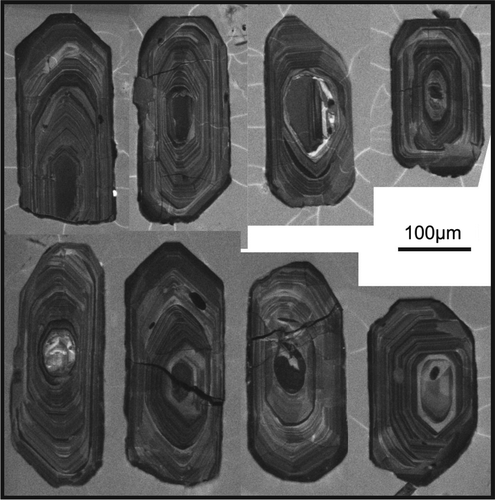
Twenty-one spots from the sample KG 07 and 17 spots from the sample 7000 have been analyzed by laser ablation (Table ). Nineteen spots from the sample KG 07 yielded 206Pb/238U ages between 387 and 404 Ma. Most of the ages are concordant (between 95 and 101%). Only two spots gave older inherited zircon ages (569 and 1754 Ma, respectively). The TuffZirc age calculated (Ludwig, Citation2003) is 393.75 + 2.35/−2.65 Ma (Figure ). Twelve spots out of 16 in the sample 7000 gave 206Pb/238U ages ranging from 391 to 404 Ma (Table ). Except for two spots (spots 3 and 16, Table ), ages are concordant (between 95% and 101%). The TuffZirc age calculated (Ludwig, Citation2003) is 395.9 + 4.0/−0.9 Ma (Figure ). Four spots gave older inherited ages (456, 548, 555 and 1767, respectively). Except for the Ordovician age from sample 7000, the ages from the two samples are very similar and indicate a Middle Devonian (ca. 395 Ma) intrusion age. These ages are also similar to those obtained in the western Sakarya Zone (399–397 Ma in Okay et al., Citation1996, 2006; 401–389 Ma in Aysal et al., Citation2012).
Figure 6. Tera-Wasserburg diagrams of the dated samples (KG 07 and 7000). TuffZirc ages calculated (Isoplot 3.0, Ludwig, Citation2003) for the samples are given as inset diagrams. For single spot ages see Table .
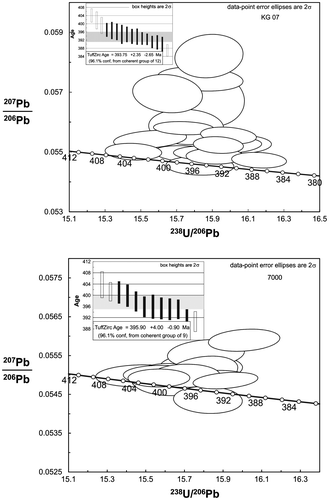
4.1.2. Biotite 40Ar/39Ar dating
Twelve biotite grains from the sample 7000 were dated using Ar–Ar laser beam method (see Analytical Techniques). The resultant Ar–Ar ages show a wide scatter (Table ) possibly because of alteration and range between 223 and 304 Ma. Probability distribution diagram of the ages is given in Figure (a) and the mean age calculation in Figure (b). Because of the wide scatter of the ages, result of the mean age calculation is not meaningful. Furthermore, Roberts, Kelley and Dahl (Citation2001)’s study has shown that different degrees of alteration in biotites give generally anomalous results. They dated fresh, partly altered and altered biotite grains using both conventional stepwise and laser Ar–Ar methods. According to their results, the amount of 36Ar increases with increasing degree of alteration. Real ages obtained from the fresh samples show smaller 36Ar/39Ar ratios and 36Ar/39Ar ratios of biotites that have different degree of alteration deviates from real age value. In Figure (c), we plotted 36Ar/39Ar ratios of the biotites against their calculated ages. Eight ratios show two different trends. Four of the values lie outside these two trends and are accepted as outliers (Figure (c)). The lowest 36Ar/39Ar ratios in two trends correspond ~285 and 291 Ma, respectively. This Early Permian age can possibly be interpreted as the age of low-grade metamorphism or alteration. However, the data can be further evaluated by assuming that fresh biotite would have the lowest 36Ar/39Ar ratio, which would also represent the “true” metamorphic age; in this case, the trend of altered 36Ar/39Ar ratios should join in a point where 36Ar/39Ar ratio is the minimum (ratio of theoretical fresh biotite). In our data set, trends of 36Ar/39Ar ratios crosscut in an age value of ~307 Ma (late Carboniferous). However, it is not possible to judge which approach is more correct, and it can only be said that the Ar–Ar data indicate low-grade metamorphism and/or alteration close to the Permian–Carboniferous boundary.
Table 2. 40Ar/39Ar age results of UV laser microprobe analysis of individual biotite grains.
Figure 7. Ar–Ar age plots of the individual biotite grains; (a) relative probability distribution of the ages, (b) mean age calculation of the ages (Isoplot 3.0, Ludwig, Citation2003), (c) 36Ar/39Ar vs. age distribution of the ages (adopted from Roberts et al., Citation2001). See text for details.
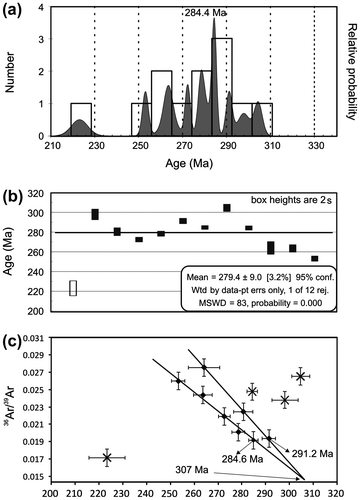
A similar scatter of K-Ar biotite ages was obtained by Delaloye and Bingöl (Citation2000). In their study three different biotites separate yielded ages between 199 and 298 Ma. This shows that Ar-based dating methods do not give satisfactory results for the intrusion age of the Karacabey Pluton.
4.1.3. Zircon (U-Th)/He dating
Three zircon grains from the sample 7000 have been analyzed using (U-Th)/He dating method. Results are given in Table . (U-Th)/He ages range between 83 and 106 Ma (Albian–Santonian). Unweighted average of three zircon ages is 93.0 ± 6.9 Ma (Table , Turonian). The zircon (U-Th)/He thermochronometer has a closure temperature of 170–190 °C and correlated with K-feldspar 40Ar/39Ar cooling temperature (Reiners, Spell, Nicolescu & Zanetti, Citation2004).
Table 3. Zircon (U-Th)/He age results of the sample GK 07.
4.2. Major and trace element geochemistry
In this study, four samples from the Karacabey Pluton were analyzed for their geochemistry (Table ). All the samples are from the biotite-rich granodiorite. Two samples are collected from the western part of the pluton and two from the east (Figure ). The main difference between western and eastern samples is the presence of hornblende in western ones (Figure ). The eastern samples have the mineral assemblage of quartz, plagioclase, K-feldspar, biotite and minor apatite, zircon and opaque minerals, whereas those from the east have hornblende and titanite in addition to the minerals above.
Table 4. Geochemical analyzes of granodiorite of the Karacabey Pluton.
Modal compositions of the samples fall into the granodiorite field when plotted on SiO2 vs. total alkali diagrams (Figure , Middlemost, Citation1985). In AFM classification (Irvine & Baragar, Citation1971), they plotted in the field of calc-alkaline series. On the SiO2 vs. K2O (Peccerillo & Taylor, Citation1976) diagram, all samples plotted in the field of high-K calc-alkaline series (Figure ). The samples collected from the western part of the pluton (KG 07 and 17) fall in the peraluminous I-type field whereas those from the east plot in the S-type area of Shand (Citation1943) (Figure ).
Figure 8. Geochemical nomenclature of the samples of the Karacabey Pluton in total alkali vs. SiO2 diagram (Middlemost, Citation1985). They all fall into the granodiorite fields.
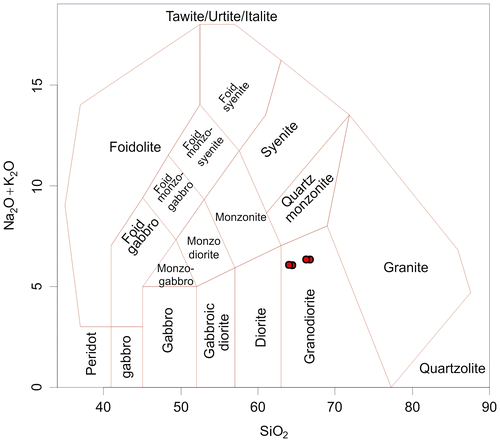
Figure 9. The AFM and K2O-SiO2 diagrams of Irvine and Baragar (Citation1971) and Peccerillo and Taylor (Citation1976), respectivelly. All samples belong to the high-K, calc-alkaline series.
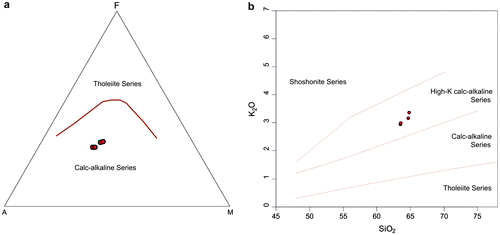
Figure 10. The distribution of the samples in A/CNK-A/NK diagram of Shand (Citation1943). All samples are peraluminous in character but western samples are I-type whereas eastern samples are S-type.
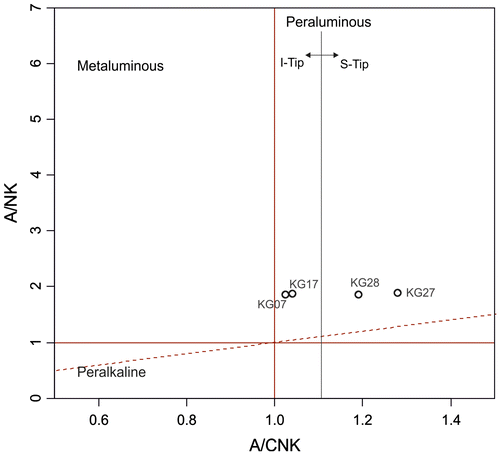
SiO2 amounts of the samples vary between 63 and 65%. TiO2, Fe2O3, MgO, CaO and Na2O amounts of the western samples are higher than the eastern ones. Only K2O amount of the eastern samples is higher than the western samples. The Al2O3 amount and Mg# do not change between the samples (Table ).
In SiO2 vs. trace element diagrams, the differences between these two regions are more evident (Figure ). Especially, Y, Zr, La and Ce amounts differ significantly. Y, Zr, La and Ce are incompatible and immobile elements, and their variations should be dependent on the different magmatic origins of the rocks. However, elements such as Rb and Ba are compatible and mobile elements, and they show only changes according to their SiO2 amounts (Figure ). The Y, Zr, La and Ce amounts of the western samples (KG 07 and 17) are higher than the eastern samples (KG 27 and 28).
Figure 11. Harker diagrams of the samples analyzed. Note that only elements Y, La, Ce and Zr reveal real difference when plotted against their SiO2 amounts. Other elements such as Rb, Sr and Ba show only distribution according to their SiO2 amounts.
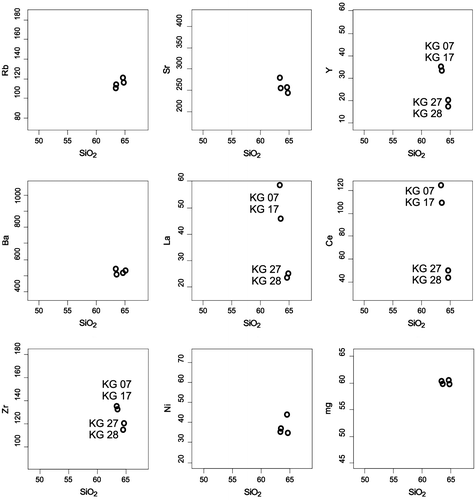
In the chondirite normalized spider diagram, La, Ce, Nd, Tb, Y, Tm and Yb ratios of the eastern samples are different from the western samples (Figure (a), Sun & Mcdonough, Citation1989). The western samples KG 07 and 17 have higher values. However, other elements have similar pattern for all samples in both regions. All samples exhibit negative anomalies of Ta and Nb relative to their adjacent LILE (large-ionlithophile elements: Sr, K, Rb, Ba and Th) and LREE (light rare earth elements: La to Nd). These geochemical features are characteristic for arc-related magmas (e.g. Pearce & Peate, Citation1995). In the chondrite normalized REE pattern (Figure (b), Nakamura, Citation1974), the western samples are much enriched than the eastern samples. The Lan/Ybn values are 7.5 and 9.6 for the eastern samples, and 12.4 and 12.5 for western samples (Table ). The clear difference between the samples is the western samples have strong negative Eu anomaly, whereas the eastern samples do not. The negative Eu anomalies (Eun/(Smn × Gdn)0.5) are 0.75 and 0.79 for the eastern samples and 0.41 and 0.45 for western ones. The strong negative anomaly in the eastern samples reveals that they have fractionation of plagioclase during their magma chamber evolution. Although samples have some differences between the western and the eastern samples, it should be taken into account that the later events such as metamorphism and alteration, as it was revealed by the scatter of Ar–Ar ages, can cause such differences in the geochemical characteristics of the samples. This is clearly seen in their alumina saturation characteristics. Samples are distributed from I- and S-type characteristics. Field observations show that exposures of both rock types are transitional and U-Pb zircon ages obtained from both rock types are identical.
Figure 12. Multi-element spider and REE distribution of the samples from the Karacabey Granitoid. Normalization values are; (a) primitive mantle from Sun and Mcdonough (Citation1989) and (b) chondirite from Nakamura (Citation1974). Note that only western samples (KG 07 and 17) have negative Eu anomaly. Shaded area represents distribution of the samples analyzed in Aysal et al. (Citation2012).
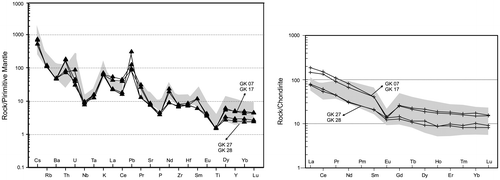
4.3. Sr-Nd isotope geochemistry
All of the samples have similar Sr initial isotopic ratios between 0.709735 and 0.711698 (Table ). Their Nd initial ratios are also similar to each other (0.51165–0.51173). Initial epsilon Nd values of the western samples (−9.4 and −8.5) are slightly higher than the eastern samples (−8.2 and −7.8). In the Sr(i) vs. epsilon Nd(i) diagram, all samples plotted into the field between lower continental crust of metaigneous and metapelitic sources (Figure ). A similar isotopic distribution was also obtained from Devonian granitoids in other parts of the western Sakarya Zone (see Figure , Aysal et al., Citation2012).
Table 5. Sr and Nd isotopic data of the samples of the Karacabey Pluton.
Figure 13. ƐNd(393) vs. 87Sr/86Sr(393) diagram of the analyzed granodiorites. MORB (Mid-ocean ridge basalts), OIB (Ocean island basalts), BSE (Bulk silicate earth) and DMM (Depleted MORB mantle) fields are after Zindler and Hart (Citation1986); LM (Lithospheric mantle) is from Yang, Wu, Chung, Wilde, and Chu (Citation2004) and Yang, Wu, Chung, Wilde, and Chu (Citation2006); LCC (1) (lower continental crust of meta-igneous source) and LCC (2) (lower continental crust of meta-pelitic source) are from Villaseca, Downes, Pin, and Barbero (Citation1999). Pale-blue area represents distribution of the samples analyzed in Aysal et al. (Citation2012).
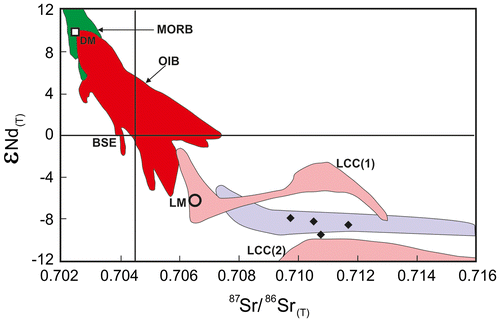
Figure 14. Tectonic discrimination of the samples in the Pearce et al. (Citation1984) diagrams. Pale-blue area represents distribution of the samples analyzed in Aysal et al. (Citation2012).
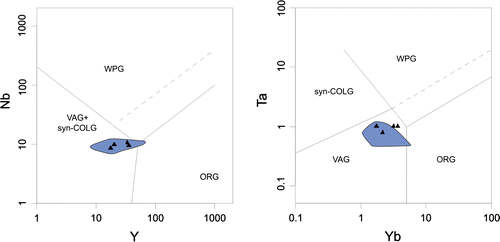
5. Discussion
5.1. The Variscan magmatism in the Sakarya Zone
Early-Middle Devonian granitoids in the western Sakarya Zone have been first reported by Okay et al. (Citation1996, Citation2006). More recently Aysal et al. (Citation2012) showed a wider distribution of the Early-Middle Devonian granitoids in the Biga Peninsula in the western Sakarya Zone. No other evidence of Devonian magmatism is known in the Pontides or in Turkey in general, except detrital zircons of Devonian age, reported from the Yusufeli Area (Ustaömer, Robertson, et al., Citation2012) and from the Late Carboniferous metasediments in the Strandja Massif (Sunal, Natal’in, Satır & Toraman, Citation2006).
In contrast to the scarcity of the Devonian magmatism, Carboniferous and Permian granitoids crop out widely in the Sakarya Zone. In the central Sakarya zone, to the north of Eskisehir, granitoids of 319–327 Ma old have been published by Ustaömer, Ustaömer, et al. (Citation2012). In the central Pontides, Nzegge et al. (Citation2006) dated several granitoids between 303 and 275 Ma. In the eastern Sakarya Zone, 318–329-Ma-old granitoids from Gümüşhane and surrounding plutons have been dated by Topuz et al. (Citation2010) and Dokuz (Citation2011). Recently, Ustaömer, Robertson, et al. (Citation2012) published 356–325-Ma-old magmatics in the Yusufeli area (the eastern Sakarya zone).
The presence of the garnet-bearing leucocratic granitoids in the region (not analyzed in this study) and inherited cores in the zircons in the dated samples indicate contribution of Precambrian continental crust to generation of Middle Devonian magmas. Furthermore, TDM (age of the depleted mantle) values (1.5–1.96 Ga, Table ) also suggest involvement of the older crust to the Middle Devonian magma generation. Isotopic data show compositions close to the lower crustal values (Figure ). However, high Mg# of the samples (~60) is also indicative of a basic magma derived from a mantle source. Karacabey Pluton has distinct Nb and Ta anomalies, which is commonly take as a subduction sign (Baier, Audétat & Keppler, Citation2008). Samples from the granodiorite also plot in the fields of volcanic-arc magmatics on the tectonic discrimination diagrams of Pearce, Haris and Trindle (Citation1984) (Figure ). Besides, isotopic characteristics of the samples are very close to the enriched mantel source (EMII in Zindler & Hart, Citation1986) that represented by low Nd but generally high and variable Sr isotopic ratios. Zindler and Hart (Citation1986) stated different involvements of the mechanisms to generation of EMII but also stated that they always play roles in convergent plate boundaries. Aysal et al (Citation2012) also described Early-Middle Devonian magmatics with similar petrography and geochemistry from farther west; they interpreted their genesis to delamination and/or slab-breakoff but also discussed subduction possibility. Even they show differences in their petrography and some geochemical characteristics, later events are able to change geochemistry of the rocks, especially alteration. Thus, we interpret our geochemical data obtained from the Middle Devonian granodiorites as subduction related.
5.2. The Variscan metamorphism in the Sakarya Zone
The Variscan high to low degree metamorphism in the Sakarya Zone is described from different regions and with different ages (Figure ). The oldest metamorphic event is a HP/LT metamorphism in the Eastern Pontides of Middle Devonian age (Topuz, Altherr, Schwarz, Zack & Sunal, Citation2009). The age of the granulite facies metamorphism in the Pulur region, in the Eastern Pontides, is determined between 331 and 323 Ma (Topuz & Altherr, Citation2004; Topuz et al., Citation2001, Citation2004a; Topuz, Altherr, Schwarz, Dokuz & Meyer, Citation2007). The cooling of the granulite facies metamorphic rocks to 300 Co lasted to c. 310 Ma (Topuz et al., Citation2004a). The timing low-grade metamorphism in the Pulur region is much younger than high grade metamorphism (~260 Ma, Topuz, Altherr, Satır, & Schwarz, Citation2004b). Beside this direct data, rims of the detrital zircons from pre-Early Jurassic metaclastic rocks reveal two different intervals for metamorphism in the eastern Sakarya Zone (Ustaömer, Robertson, et al., Citation2012). First event dated is about 334 Ma, and the younger one is about 314 Ma. Ustaömer, Robertson, et al. Citation(2012) claim that these two metamorphic events were separated by a hiatus (320–325 Ma). In the western Sakarya Zone, in Kazdağları region, the age of high grade metamorphism is given as c. 319 Ma (Okay et al., Citation1996, Citation2006).
The K-Ar ages from the western Sakarya zone show a wide scatter, and generally fall within the Permian; those from the Karacabey Pluton range from 199 to 298 Ma (K-Ar method, Delaloye & Bingöl, Citation2000) somewhat similar to our Ar–Ar biotite results (223–304 Ma). In Söğüt region, K-Ar biotite and Pb-Pb zircon evaporation ages are ~290 Ma (Çoğulu & Krummenacher, Citation1967; Çoğulu, Delaloye & Chessex, Citation1965), and one Ar–Ar amphibole age is 272 ± 2 Ma (Okay, Monod & Monié, Citation2002). However, the granitoid ages in these regions are known to be Carboniferous, hence younger ages from the granitoids should represent later metamorphic (heating?) events. The timing of low-grade metamorphism in the western Sakarya Zone may correspond to the Permian low-grade metamorphism reported from the Eastern Pontides (Topuz et al., Citation2004a).
5.3. Thermal History of the region
Thermal history of the Karacabey region is given in Figure . The main constraints are the ages obtained from minerals with different isotopic closure temperatures (this study), and the apatite fission-track ages published by Cavazza, Federici, Okay, and Zattin (Citation2012) from the nearby areas and the stratigraphy of the region (indicated as A, B, C and D in Figure ). Time-temperature pathways of the Karacabey region are indicated as numbers in Figure .
Figure 15. Thermal history of the Karacabey region calculated using computer program HeFTy (Ketcham, Citation2005). Constraints are (A) Early-Middle Jurassic regional unconformity, (B) Late Jurassic- Early Cretaceous rifting and carbonate deposition, (C) Santonian regional unconformity, (D) Eocene deposition and relevant burial. Oligocene apatite FT age (c. 33 Ma) are from Cavazza et al. (Citation2012). For references related to other constraints see text. Thermal pathways (numbers) are explained in the text in detail. Green lines represent acceptable paths and pink lines good pats. Thick black line is the best-fit model path and blue thick line is the weighted mean path.
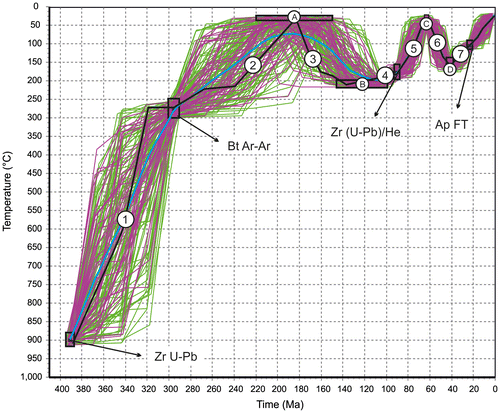
The first pathway (number 1 in Figure ) is constructed between the zircon U-Pb and biotite Ar-Ar ages obtained in this study. The uncertainty here is the lack of data between Middle Devonian and end of Permian. The second pathway (number 2) is constrained between the biotite Ar-Ar ages and the Early Jurassic unconformity (indicated as A in Figure ). The Karacabey Pluton and the metamorphic rocks of the Lower Karakaya Complex were juxtaposed by thrusting before the Early Jurassic, as shown by a common Lower Jurassic sedimentary cover. The third pathway represents the reburial of the Karacabey Pluton under the Jurassic-Cretaceous sedimentary cover. During this event, the Karacabey Pluton must have been subjected to the temperatures of over 200 °C because zircons from the granitoid have been reset for (U/Th)-He system, suggesting burial to depths of over 5–6 km’s. The fourth pathway is between Early Jurassic deposition and the Zr (U/Th)-He ages, indicating cooling to temperatures of 170–190 °C (Reiners et al., Citation2004). After resetting Zr (U/Th)-He ages during post-Jurassic burial, blocking of the Zr (U/Th)-He ages occurred during the Late Cretaceous (Turonian) possibly related to uplift and erosion. Akbayram, Okay and Satır (Citation2013) have claimed that main closure of the Intra-Pontide suture is at Early Cretaceous (latest age was given as c. 112 Ma), which might have induced regional uplift as also shown by the stratigraphy of the Cretaceous sequences in the Bursa region (Özgörüş, Okay, & Özcan, Citation2009).
The fifth pathway drawn between zircon (U/Th)-He age obtained in this study and the exhumation due to closure of the Neo-Tethys Ocean. After closure of the Neo-Tethys Ocean, during almost whole Paleocene interval, regional uplift and subsequent erosion occurred in the Sakarya Zone (Okay & Tüysüz, Citation1999; Okay et al., Citation1996; Şengör & Yılmaz, Citation1981). The pathway 6 represents Eocene deposition that unconformably overlies all units beneath (see Cavazza et al., Citation2012 and the references therein) and concerning burial and reheating. Reheating is deduced from opening of the apatite FT ages during Eocene interval. The apatite FT ages at surrounding regions of the Karacabey region were given as c. 33 Ma (Cavazza et al., Citation2012). This indicates that just after deposition of Eocene volcanic and clastics, region started to exhume during early Oligocene.
5.4. Regional implications
In the European Variscides opening of the Rheic Ocean (Proto-Tethys) started in the Late Cambrian-Early Ordovician (e.g. von Raumer & Stampfli, Citation2008; Schät, Reischmann, Tait, Bachtadse, Bahlburg & Martin Citation2002). The initiation of subduction has been assigned to Silurian-Early Devonian (Dokuz et al., Citation2011; Kröner & Romer, Citation2013; Matte, Citation2001; Reischmann & Anthes, Citation1996; Stampfli, Citation2000; von Raumer & Stampfli, Citation2008; von Raumer, Stampfli & Bussy, Citation2003) and almost in every region where the Variscan orogeny is defined, granitoids belonging to this interval have been reported. In the European Variscides, main arc-related magmatism is constrained between Devonian and Early Carboniferous (410–350 Ma, Kröner & Romer, Citation2013; Neubauer & Handler Citation2000) and magmatism between 325 and 310 Ma is regarded as post-collisional (Siebel, Chen, & Satır, Citation2003). Especially in the northern Carpathians, Bohemian Massif and Massif Central Early-Middle Devonian granitoids are widely described (see Kröner and Romer (Citation2013) for the review of Variscan orogeny in Europe). However, Matte (Citation2001) has claimed that during the Variscan orogeny, the Himalayan-type orogeny occurred in Europe in Early Carboniferous interval (~345 Ma) but at the same time the Andean-type orogeny was still active in the east (most probably in the Pontides). In the Sakarya Zone, even if we consider the older metamorphism, it is still younger than the European ones. The intense magmatic activity in the Sakarya Zone occurred between 330 and 318 Ma (except one age gave 354 Ma, Ustaömer, Robertson, et al., Citation2012). Even if there is no age data published between 390 and 354 Ma, starting from Early Devonian, most probably subduction was active during the whole Paleozoic Era in the Sakarya Zone and its neighboring regions. One of the evidence of this early subduction is Middle Devonian blueschist metamorphism documented in the Eastern Sakarya Zone (Topuz et al., Citation2009). In the eastern Sakarya Zone, Dokuz et al. (Citation2011) proposed a dual subduction model for the closure of the Rheic Ocean. Their model constructed according to special distribution of the mantle and metamorphic rocks in the region. Their dual subduction model infers collision of Andean-type continental margin in the north while the southward directed SSZ in the south (Dokuz et al., Citation2011).
Furthermore, in Sredna Gora region (Bulgaria), eclogite bearing amphibolites yielded 398.4 ± 5.2 Ma (Ar–Ar dating on hornblende, Cortesogno, Gaggero, Haydoutov & Buzzi, Citation2005). In the southern Carpathians, the timing of HP metamorphism is younger. Medaris, Ducea, Ghent and Iancu (Citation2003) have reported that age of prograde eclogite metamorphism as between 358 and 342 Ma. Taking into account all data outlined above and our new results, similar to European history of the Rheic Ocean, subduction of the Rheic Ocean started in the Sakarya Zone in Early Devonian and most probably lasted during the whole Paleozoic Era and closure of the Rheic Ocean and subsequent orogeny occurred during Late Carboniferous and most probably Early Permian interval.
6. Conclusions
The Karacabey Pluton in the western Sakarya Zone, west of Bursa is a large magmatic body, previously considered as of Permian age, and in tectonic contact with the probably Triassic metamorphic rocks of the Lower Karakaya Complex. Here, it is shown to be an Early Devonian intrusion with 395 Ma U-Pb zircon ages. The geochemistry of the granitoid suggests an arc-related magmatic setting. Along with the other Devonian granitoids in the western part of the Sakarya Zone (Aysal et al., Citation2012; Okay et al., Citation1996, Citation2006), the Karacabey Pluton is considered to have been formed in a subduction setting.
The Karacabey Pluton had a long complex thermal history. New Ar–Ar biotite ages suggest thermal reheating during the Permian–Carboniferous boundary. It was exhumed during the Early Jurassic, when sandstones and conglomerates were deposited on the Karacabey Pluton and on the Triassic metamorphic rocks of the Lower Karakaya Complex; the clastic rocks were succeeded by the deposition of the Upper Jurassic-Lower Cretaceous carbonates. The uplift occurred during the Late Cretaceous (Turonian) as deduced from zircon (U-Th)/He dating. This event is probably related to the Closure of the Intra-Pontide Ocean in the north of the Sakarya Zone (Akbayram et al., Citation2013).
Acknowledgments
This study was supported by TÜBITAK (The Scientific and Technical Research Council of Turkey, Project No: CAYDAG 111Y314). I wish to thank W. Siebel and E. Reitter for help in isotopic measurements. I warmly thank M.K. Erturaç for assist in the field studies. I sincerely thank A.I. Okay who proposed this study and provided some of the samples. A.I. Okay is also thanked for reading early draft of the manuscript and making numerous changes and constructive comments. I thank S. Sherlock for Ar–Ar dating. I wish to thank A.R.C. Kylander-Clark for U-Pb dating of the rocks. A special thank is due to I. Dunkl for (U-Th)/He dating of zircons. E. Aydar and E. Çubukçu are thanked for helping CL imaging in Hacettepe University. Detailed comments and editorial handlings of E. Bozkurt, constructive reviews by E. Koralay and O. Karslı are greatly appreciated.
References
- Akbayram, K., Okay, A. I., & Satır, M. (2013). Early cretaceous closure of the intra-pontide ocean in western Pontides (northwestern Turkey). Journal of Geodynamics, 65, 38–55.
- Altıner, D. (1991). Microfossil biostratigraphy (mainly foraminifers) of the Jurassic-Cretaceous carbonate successions in northwestern Anatolia (Turkey). Geologica Romana, 27, 167–213.
- Altunkaynak, Ş., Sunal, G., Aldanmaz, E., Genç, C. Ş., Dilek, Y., Furnes, H., … Yıldız, M. (2012). Eocene granitic magmatism in NW Anatolia (Turkey) revisited: New implications from comparative zircon SHRIMP U-Pb and 40Ar-39Ar geochronology and isotope geochemistry on magma genesis and emplacement. Lithos, 155, 289–309.
- Aysal, N., Ustaömer, T., Öngen, S., Keskin, M., Köksal, S., Peytcheva, I., & Fanning, M. (2012). Origin of the Early-Middle Devonian magmatism in the Sakarya Zone, NW Turkey: Geochronology, geochemistry and isotope systematics. Journal of Asian Earth Sciences, 45, 201–222.
- Baier, J., Audétat, A., & Keppler, H. (2008). The origin of the negative niobium and tantalum anomaly in subduction zone magmas. Earth and Planetary Science Letters, 267, 290–300.
- Cavazza, C., Federici, I., Okay, A. I., & Zattin, M. (2012). Apatite fission-track thermochronology of the Western Pontides (NW Turkey). Geological Magazine, 149, 133–140.
- Çoğulu, E., & Krummenacher, D. (1967). Geochronological problems in NW part of the Central Anatolia (Turkey). Schweizerische Mineralogische und Petrographische Mitteilungen, 47, 825–831.
- Çoğulu, E., Delaloye, M., & Chessex, R. (1965). Ages of some acidic magmatic rocks in Eskişehir region (Turkey). Archives des Sciences, Genéve, 18, 692–699.
- Cortesogno, L., Gaggero, L., Haydoutov, I., & Buzzi, L. (2005). The eclogite to amphibolite metamorphic path from the Sredna Gora terrane in the Variscan orogenic segment of Bulgaria (SE Europe). Geophysical Research Abstracts, 7, SRef-ID: 1607-7962/gra/EGU05-A-01802, European Geosciences Union.
- Delaloye, M., & Bingöl, E. (2000). Granitoids from western and northwestern Anatolia: Geochemistry and modelling of geodynamic evolution. International Geology Review, 42, 241–268.
- Dokuz, A. (2011). A slab detachment and delamination model for the generation of Carboniferous high potassium I-type magmatism in the Eastern Pontides, NE Turkey: Köse composite pluton. Gondwana Research, 19, 926–944.
- Dokuz, A., Uysal, İ., Kaliwoda, M., Karslı, O., Ottley, C. J., & Kandemir, R. (2011). Early abyssal and late SSZ-type vestiges of the Rheic oceanic mantle in the Variscan basement of the Sakarya Zone, NE Turkey: İmplications for the sense of subduction and opening of the Paleotethys. Lithos, 127, 176–191.
- Ergül, E., Gözler, Z., Akçaören, F., Bilgi, C., Dayıoğlu, Ü., Öztürk, Z., … Yalçınkaya, S. (1986). Bandırma-E 6 paftası Jeoloji Haritası [Geological map of Bandırma E-6 sheet]. Ankara: MTA.
- Farley, K. A. (2002). (U-Th)/He dating: Techniques, calibrations, and applications. In D. Porcelli, C. J. Ballentine, & R. Wieler (Eds.), Noble gases in geochemistry and cosmochemistry. Review in Mineralogy and Geochemistry (Vol. 47. pp. 819–843). Washington, DC: Mineralogical Society of America.
- Farley, K. A., Wolf, R., & Silver, L. (1996). The effects of long alpha-stopping distances on (U-Th)/He ages. Geochimica et Cosmochimica Acta, 60, 4223–4229.
- Irvine, T. M., & Baragar, W. R. (1971). A guide to the chemical classification of common volcanic rocks. Canadian Journal of Earth Sciences, 8, 523–548.
- Jacobsen, S. B., & Wasserburg, G. J. (1980). Sm-Nd isotopic evolution of chondrites. Earth and Planetary Science Letters, 50, 139–155.
- Kaygusuz, A., Arslan, M., Siebel, W., Sipahi, F., & İlbeyli, N. (2012). Geochronological evidence and tectonic significance of Carboniferous magmatism in the southwest Trabzon area, eastern Pontides, Turkey. International Geology Review, 54, 1776–1800.
- Ketcham, R. A. (2005). Forward and inverse modeling of low-temperature thermochronometry data. In P. W. Reiners, & T. A. Ehlers (Eds.), Low-temperature thermochronology: Techniques, interpretations, and applications. Review in Mineralogy and Geochemistry, (Vol. 58, pp. 275–314). Washington D.C.: Mineralogical Society of America.
- Kröner, U., & Romer, R. L. (2013). Two plates-many subduction zones: The Variscan orogeny reconsidered. Gondwana Research, 24, 298–329.
- Kylander-Clark, A. R. C., Hacker, B. R., & Cottle, J. M. (2013). Laser-ablation split-stream ICP petrochronology. Chemical Geology, 345, 99–112.
- Liew, T. C., & Hofmann, A. W. (1988). Precambrian crustal components, plutonic associations, plate environment of the Hercynian Fold Belt of Central Europe: Indications from a Nd and Sr isotopic study. Contributions to Mineralogy and Petrology, 98, 129–138.
- Ludwig, K. R. (2003). User’s manual for Isoplot/Ex, Version 3.0, A geochronological toolkit for Microsoft Excel. Berkeley Geochronology Center Special Publication, 4, 1–74.
- Matte, P. (2001). The Variscan collage and orogeny (480–290 Ma) and the tectonic definition of the Armorica microplate: A review. Terra Nova, 13, 122–128.
- Medaris, G., Jr., Ducea, M., Ghent, E., & Iancu, V. (2003). Conditions and timing of high-pressure Variscan metamorphism in the South Carpathians, Romania. Lithos, 70, 141–161.
- Middlemost, E. A. K. (1985). Magmas and magmatic rocks, an introduction to igneous petrology. London: Longman.
- Nakamura, N. (1974). Determination of REE, Ba, Fe, Mg, Na and K in carbonaceous and ordinary chondrites. Geochimica et Cosmochimica Acta, 38, 757–775.
- Neubauer, F., & Handler, R. (2000). Variscan orogeny in the Eastern Alps and Bohemian Massif: How do these units correlate? Mitteilungen der Österreichischen geologischen Gesellschaft, 92, 35–59.
- Nzegge, O. (2008). Petrogenesis and geochronology of the Deliktaş, Sivrikaya and Devrekani granitoids and basement, Kastamonu belt-Central Pontides (NW Turkey): Evidence for Late Palaeozoic-Mesozoic plutonism and geodynamic interpretation (Unpublished doctoral dissertation). University of Tübingen, Germany.
- Nzegge, O., Satır, M., Siebel, W., & Taubald, H. (2006). Geochemical and isotopic constraints on the genesis of the Late Paleozoic Deliktaş and Sivrikaya granites from the Kastamonu granitoid belt (Central Pontides, Turkey). Neues Jahrbuch für Mineralogie Abhandlungen, 183, 10–27.
- Okay, A. I., & Göncüoğlu, C. M. (2004). The Karakaya complex: A review of data and concepts. Turkish Journal of Earth Sciences, 13, 77–95.
- Okay, A. I., & Monié, P. (1997). Early Mesozoic subduction in the Eastern Mediterranean: Evidence from Triassic eclogite in northwest Turkey. Geology, 25, 595–598.
- Okay, A. I., & Tüysüz, O. (1999). Tethyan sutures of northern Turkey. In B. Durand, I. Jolivet, F. Horváth, & M. Séranne (Eds.), The Mediterranean Basins: Tertiary extension within the Alpine Orogen (pp. 475–515). London: Geological Society. Special Publications 156.
- Okay, A. I., Satır, M., Maluski, H., Siyako, M., Monié, P., Metzger, R., & Akyüz, S. (1996). Paleo- and Neo-Tethyan events in northwest Turkey: Geological and geochronological constraints. In A. Yin, & M. Harrison (Eds.), Tectonics of Asia (pp. 420–441). Cambridge: Cambridge University Press.
- Okay, A. I., Monod, O., & Monié, P. (2002). Triassic blueschists and eclogites from northwest Turkey: Vestiges of the Paleo-Tethyan subduction. Lithos, 64, 155–178.
- Okay, A. I., Satır, M., & Siebel, S. (2006). Pre-Alpide Palaeozoic and Mesozoic orogenic events in the Eastern Mediterranean region: Geological Society, London. Memoirs, 32, 389–405.
- Özgörüş, Z., Okay, A. I., & Özcan, E. (2009). Late-Cretaceous–Eocene evolution of the western margin of the İstanbul and Sakarya Zones [Abstracts, 62]. Geological Congress of Turkey, Ankara, 462.
- Paton, C., Woodhead, J. D., Hellstrom, J. C., Hergt, J. M., Greig, A., & Maas, R. (2010). Improved laser ablation U-Pb zircon geochronology through robust downhole fractionation correction. Geochemistry Geophysics Geosystems, 11, Q0AA06. doi:10.1029/2009GC002618
- Pearce, J. A., & Peate, D. W. (1995). Tectonic implications of the composition of volcanic arc magmas. Annual Review of the Earth and Planetary Sciences, 23, 113–134.
- Pearce, J. A., Haris, N. B. W., & Trindle, A. G. (1984). Trace element discrimination diagrams for the tectonic interpretation of granitic rocks. Journal of Petrology, 25, 956–983.
- Peccerillo, A., & Taylor, S. R. (1976). Geochemistry of Eocene calc-alkaline volcanic rocks from the Kastamonu area, Northern Turkey. Contributions to Mineralogy and Petrology, 58, 63–81.
- Poller, U., Huth, J., Hoppe, P., & Williams, I. S. (2001). REE, U, TH, and HF distribution in zircon from western Carpathian Variscan granitoids: A combined and ion microprobe study. American Journal of Science, 301, 858–876.
- Reiners, P. W., Spell, T. L., Nicolescu, S., & Zanetti, K. A. (2004). Zircon (U-Th)/He thermochronometry: He diffusion and comparisons with 40Ar/39Ar dating. Geochimica et Cosmochimica Acta, 68, 1857–1887.
- Reischmann, T., & Anthes, G. (1996). Geochronology of the mid German crystalline rise west of the river Rhine. Geologische Rundschau, 85, 761–774.
- Renne, P. R., Swisher, C. C., Deino, A. L., Karner, D. B., Owens, T. L., & DePaolo, D. J. (1998). Intercalibration of standards, absolute ages and uncertainties in 40Ar/39Ar dating. Chemical Geology, 145, 117–152.
- Richard, P., Shimizu, N., & Allegre, C. J. (1976). 143Nd/144Nd, a natural tracer: An application to oceanic basalts. Earth and Planetary Science Letters, 31, 269–278.
- Roberts, H. J., Kelley, S. P., & Dahl, P. S. (2001). Obtaining geologically meaningful 40Ar-39Ar ages from altered biotite. Chemical Geology, 172, 277–290.
- Schätz, M., Reischmann, T., Tait, J., Bachtadse, V., Bahlburg, H., & Martin, U. (2002). The Early Palaeozoic break-up of northern Gondwana, new palaeomagnetic and geochronological data from the Saxothuringian Basin, Germany. International Journal of Earth Sciences, 91, 838–849.
- Şengör, A. M. C., & Yılmaz, Y. (1981). Tethyan evolution of Turkey: A plate tectonic approach. Tectonophysics, 75, 181–241.
- Shand, S. J. (1943). Eruptive rocks (2nd ed.). New York, NY: John Wiley.
- Siebel, W., Chen, F., & Satır, M. (2003). Late Variscan magmatism revisited: New implications from Pb-evaporation zircon ages on the emplacement of Redwitzites and granites in NE Bavaria. International Journal of Earth Sciences, 92, 36–53.
- Stampfli, G. M. (2000). Tethyan oceans. In E. Bozkurt, J. A. Winchester, & J. A. D. Piper (Eds.), Tectonics and magmatism in Turkey and the surrounding area (pp. 1–23). London: Geological Society. Special Publications 173.
- Sun, S. S., & Mcdonough, W. F. (1989). Chemical and isotopic systematics of oceaning basalts: Implications for mantle composition and processes. In A. D. Saunders, & M. J. Nory (Eds.), Magmatism in ocean basins (pp. 313–345). London: Geological Society. Special Publications 42.
- Sunal, G., Natal’in, B. A., Satır, M., & Toraman, E. (2006). Paleozoic magmatic events in the Strandja massif, NW Turkey. Geodinamica Acta, 19, 283–300.
- Topuz, G., & Altherr, R. (2004). Pervasive rehydration of granulites during exhumation – An example from the Pulur complex, Eastern Pontides, Turkey. Mineralogy and Petrology, 81, 165–185.
- Topuz, G., Altherr, R., Satır, M., Schwarz, W. H., & Sadıklar, B. (2001). P-T path and cooling history of high-grade gneisses from the Pulur Massif (Eastern Pontides, NE Turkey). In Europrobe Neoproterozoic – Early Paleozoic Time-Slice Symposium: Orogeny and Cratonic Response on the Margins of Baltica, 30th September – 2nd October (pp. 88–90). Ankara, Turkey: Middle East Tech. Univ.
- Topuz, G., Altherr, R., Kalt, A., Satır, M., Werner, O., & Schwarz, W. H. (2004a). Aluminous granulites from the Pulur complex, NE Turkey: A case of partial melting, efficient melt extraction and crystallisation. Lithos, 72, 183–207.
- Topuz, G., Altherr, R., Satır, M., & Schwarz, W. H. (2004b). Low-grade metamorphic rocks from the Pulur complex, NE Turkey: Implications for the pre-Liassic evolution of the Eastern Pontides. International Journal of Earth Sciences, 93, 72–91.
- Topuz, G., Altherr, R., Schwarz, W. H., Dokuz, A., & Meyer, H. P. (2007). Variscan amphibolite-facies rocks from the Kurtoğlu metamorphic complex (Gümüşhane area, Eastern Pontides, Turkey). International Journal of Earth Sciences, 96, 861–873.
- Topuz, G., Altherr, R., Schwarz, W., Zack, T., & Sunal, G. (2009). Middle Devonian blueschist metamorphism in the eastern Pontides, NE Turkey: vestiges of the Rheic Ocean? In 2nd International Symposium on the Geology of the Black Sea Region , Abstracts, 5–9 October (pp. 203–204). Ankara.
- Topuz, G., Altherr, R., Siebel, W., Schwarz, W. H., Zack, T., Hasözbek, A., … Şen, C. (2010). Carboniferous highpotassium I-type granitoid magmatism in the Eastern Pontides: The Gümüşhane pluton (NE Turkey). Lithos, 116, 92–110.
- Ustaömer, T., Robertson, A. H. F., Ustaömer, P. A., Gerdes, A., & Peytcheva, I. (2012b). Constraints on Variscan and Cimmerian magmatism and metamorphism in the Pontides (Yusufeli–Artvin area), NE Turkey from U-Pb dating and granite geochemistry. In A. H. F. Robertson, O. Parlak, & U. C. Ünlügenç (Eds.), Geological development of Anatolia and the easternmost Mediterranean region (pp. 49–74). London: Geological Society. Special Publications 372/1.
- Ustaömer, P. A., Ustaömer, T., & Robertson, A. H. F. (2012). Ion probe U-Pb dating of the central Sakarya basement: A peri-Gondwana terrane intruded by late lower Carboniferous subduction/collision-related granitic rocks. Turkish Journal of Earth Sciences, 21, 905–932.
- Villaseca, C., Downes, H., Pin, C., & Barbero, L. (1999). Nature and composition of the lower continental crust in central Spain and the granulite–granite linkage: Inferences from granulitic xenoliths. Journal of Petrology, 40, 1465–1496.
- von Raumer, J. F., & Stampfli, G. M. (2008). The birth of the Rheic Ocean – Early Palaeozoic subsidence patterns and tectonic plate scenarios. Tectonophysics, 461, 9–20.
- von Raumer, J. F., Stampfli, G. M., & Bussy, F. (2003). Gondwana-derived microcontinents—The constituents of the Variscan and Alpine collisional orogens. Tectonophysics, 365, 7–22.
- Yang, J. H., Wu, F. Y., Chung, S. L., Wilde, S. A., & Chu, M. F. (2004). Multiple sources for the origin of granites: Geochemical and Nd/Sr isotopic evidence from the Gudaoling granite and its mafic enclaves, northeast China. Geochimica et Cosmochimica Acta, 68, 4469–4483.
- Yang, J. H., Wu, F. Y., Chung, S. L., Wilde, S. A., & Chu, M. F. (2006). A hybrid origin for the Qianshan A-type granite, northeast China: Geochemical and Sr-Nd-Hf isotopic evidence. Lithos, 89, 89–106.
- Zindler, A., & Hart, S. (1986). Chemical geodynamics. Annual Review of Earth and Planetary Science Letters, 14, 493–571.
